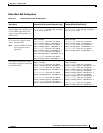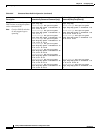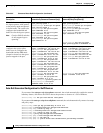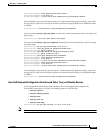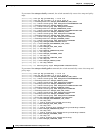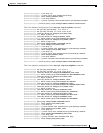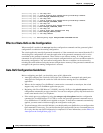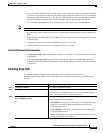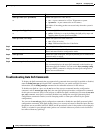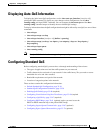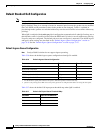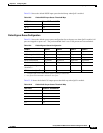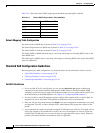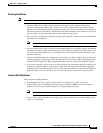
33-33
Catalyst 2960 and 2960-S Switch Software Configuration Guide
OL-8603-09
Chapter 33 Configuring QoS
Configuring Auto-QoS
• After auto-QoS is enabled, do not modify a policy map or aggregate policer that includes AutoQoS
in its name. If you need to modify the policy map or aggregate policer, make a copy of it, and change
the copied policy map or policer. To use this new policy map instead of the generated one, remove
the generated policy map from the interface, and apply the new policy map to the interface.
• You can enable auto-QoS on static, dynamic-access, voice VLAN access, and trunk ports.
Note VLAN-based QoS is not supported on Catalyst 2960-S switches.
• By default, the CDP is enabled on all ports. For auto-QoS to function properly, do not disable the
CDP.
• When enabling auto-QoS with a Cisco IP Phone on a routed port, you must assign a static IP address
to the IP phone.
• This release supports only Cisco IP SoftPhone Version 1.3(3) or later.
• Connected devices must use Cisco Call Manager Version 4 or later.
Auto-QoS Enhanced Considerations
• The auto qos srnd4 global configuration command is generated as a result of enhanced auto-QoS
configuration.
• If the legacy auto qos voip commands are executed on the switch and the mls qos command is
disabled, the enhanced auto-QoS configuration is generated. Otherwise, legacy auto-QoS commands
are executed.
Enabling Auto-QoS
For optimum QoS performance, enable auto-QoS on all the devices in your network.
Beginning in privileged EXEC mode, follow these steps to enable auto-QoS devices within a QoS
domain:
Command Purpose
Step 1
configure terminal Enter global configuration mode.
Step 2
interface interface-id Specify the port that is connected to a video device or the uplink port
that is connected to another trusted switch or router in the network
interior, and enter interface configuration mode.
Step 3
auto qos voip {cisco-phone |
cisco-softphone | trust}
or
Enable auto-QoS.
The keywords have these meanings:
• cisco-phone—If the port is connected to a Cisco IP Phone, the
QoS labels of incoming packets are trusted only when the
telephone is detected.
• cisco-softphone—The port is connected to device running the
Cisco SoftPhone feature.
• trust—The uplink port is connected to a trusted switch or router,
and the VoIP traffic classification



